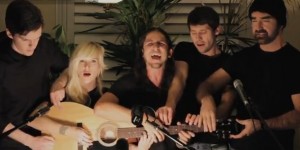 Music
Music
Sob story from band that lost $11,000 was actually a marketing stunt
by Mark Teo
December 1, 2014
Last week, indie-folk duo Pomplamoose earned plenty of chatter after they revealed that, while taking the band on tour, they sold over $100,000 in tickets—but still emerged from their tour in the red, losing $11,000. That number felt sobering: In a post originally published on Medium, band member Jack Conte said that operating a band was a small business and a labour of love. Even bands who “make it,” suggested Conte—and they toured with a full crew, sold boatloads of tickets, and have more than 100 million YouTube views—still don’t turn a profit.
It was, undoubtedly, a shame: Our first reaction questioned how the creative class could survive. If a successful indie pop band can’t turn a profit, how could other artists, illustrators, designers, and musicians survive?
But still, Conte’s post felt a little too smarmy to be a criticism of the music business—it, in his words, wasn’t meant to be a “sob story,” and the band still felt lucky to be able to tour. (And yes, they should feel lucky—operating at an $11,000 loss suggests that they are, indeed, privileged.) Then, the details didn’t add up: How did the band spend $50,000 paying their tour crew? How did they spend $26,000 renting equipment? Why did the band rent out four Best Western-level hotel rooms for each night of the tour, when most smaller-level bands sleep on floors? How, exactly, were they able to put $17,000 on one of their credit cards?
It began to feel like Pomplamoose weren’t exactly a run-of-the-mill D.I.Y. touring band. And in the final lines of Conte’s post, he reveals that they’re not.
We’re entering a new era in history: the space between “starving artist” and “rich and famous” is beginning to collapse. YouTube has signed up over a million partners (people who agree to run ads over their videos to make money from their content). The “creative class” is no longer emerging: it’s here, now.
We, the creative class, are finding ways to make a living making music, drawing webcomics, writing articles, coding games, recording podcasts. Most people don’t know our names or faces. We are not on magazine covers at the grocery store. We are not rich, and we are not famous.
We are the mom and pop corner store version of “the dream.” If Lady Gaga is McDonald’s, we’re Betty’s Diner. And we’re open 24/7.
It seems innocent enough, right? Well, not exactly. What Conte hasn’t revealed, here, is that, along with playing in Pomplamoose, he’s the co-founder of a site called Patreon—which provides crowd-funding for those comic artists, those podcasters, those writers. No, his tale of Pomplamoose’s tour woes wasn’t a sob story—it was as thin-veiled marketing piece for Patreon.
At the end of the day, Pomplamoose is just fine: our patrons give us $6,326 per video through our Patreon page.
And it adds up: How, exactly, were they able to put $17,000 on a credit card? We can’t comment on Conte’s finances specifically, but it may have something to do with the fact that Patreon has raised $17 million dollars from venture capitalists and angel investors—and skims 5 per cent commission from those who use their site. Factor in the $6,326 figure Conte cited above with the fact that they’re producing two videos a month and the number grows further.
This, of course, isn’t a bad thing—Patreon has funded plenty of creative ventures we love, like Jesse Brown’s Canadaland podcast. Still, as Andrew Choi writes, it’s disingenuous—unethical, even—to write a story about the hardships of creative work when, thanks to Patreon, he runs a platform that benefits directly from it.
This was branded content, and we’d appreciate it if it was labeled as such.
Tags: Music, News, pomplamoose, wtf





